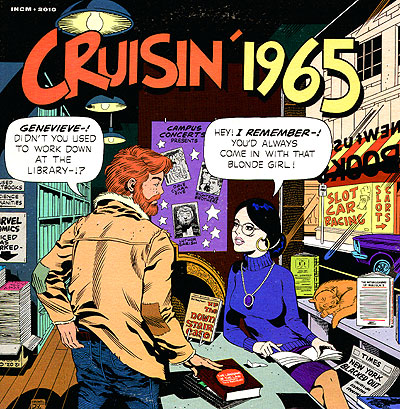
 |
 ORIGINAL LP COVER NOTES
ORIGINAL LP COVER NOTESBy Pete Johnson The kind of radio known as Top 40 (though its practitioners might vary from Terrific 20 to Boss 30 to Fantastic 50) never got much better than it was in 1965, the year this volume of the CRUISIN' series alights at Los Angeles radio station KHJ amid Robert W. Morgan's morning show. KHJ was a miraculous overnight success in the competitive Los Angeles radio market, an area which for nearly a decade had been dominated by KFWB, its Fab 40 and a roster of disc jockeys whose names were as familiar as the offramps of the Hollywood Freeway. KHJ's "Boss Radio" was introduced to Los Angeles at 3 p.m. May 5, 1965, at 930 kilohertz on the AM dial — a mere 50 kilohertz sneeze away from KFWB/Channel 98. Within five months, 93/KHJ had surged past the rock competition — KFWB, KRLA and KBLA — to inaugurate a rule over Southern California Top 40 radio which has extended well into the 1970s. So profound was KFWB's ignominy that it changed to all-news a short time later, retiring from the musical fray. KHJ was the flagship station of a chain programmed by Bill Drake (whose voice opens this record with the announcement, "And now, ladies and gentlemen, Robert W. Morgan!"), a man whose sense of pop music radio was so acute that he became the most influential person in Top 40 radio — and hence in the making of American hit singles — in the latter half of the Sixties. During this period he programed or consulted stations which dominated Los Angeles, San Francisco, Boston, Detroit, Memphis, Fresno and San Diego.
KHJ was strong, shiny, clean, bright and tight. Its structure was so precise that the disc jockey became just another element in its flawless mix, a resonant, friendly, professional voice blending between music, commercials, contests ("The Big Kahuna is coming!" "Here's another clue in the Batphone Secret Number contest!"), 20/20 News, public service announcements and station identifications and promotions. He became just another element, that is, unless he were someone on the order of the The Real Don Steele ("Tina DelGado is alive!!!" a lady would shriek mysteriously, prompting a shower of exclamation-pointed, high-velocity, loosely-rhymed
Morgan (and Steele, and Sam Riddle, and a few others) was able to assert his identity through the fractions of minutes the Bill Drake format allowed disc jockeys. His confidence drove him to take chances few others would dare within those small crevices of time and his wit enabled him to make them good. Robert W. Morgan was among the first to take telephone calls over the rapids of Top 40 radio, bringing the idea of the vastly popular radio talk shows into a new area. His quick intelligence is coupled with a near-perfect radio voice: rich and deep and clear, with the uncolored enunciation which is the inheritance of those raised in Ohio. Born in Mansfield, Ohio, Morgan grew up in nearby Galion, a small town. He attended the College of Wooster, 45 miles east of Galion, but his studies succumbed to his interest in WWST-AM/FM, which served Wooster's 15,000 population and the surrounding agricultural area. After a spell of reading Farm Reports over WWST, Morgan moved to Los Angeles, determined to make it in the Big City. The Big City wasn't listening to Robert W., though, so he headed north to Oxnard, Cal. (pop. 40,000), where he landed at KACY. The Army intervened for three years, during which he managed to do two shows a day at KMBY at Monterey (pop. 22,000) by sneaking off-base from Fort Ord, using the name Mark Caroll on the air. Next came KMAK in Fresno (130,000). He moved to KROY in Sacramento (190,000) in 1963, working there as Program Director and as Morning Man. This stint was followed by eight months at KEWB in San Francisco. In each market, Morgan earned top audience ratings. Then came KHJ in Los Angeles (pop. 2.4 million). By the time he returned to "Boss Angeles," Robert W. Morgan was a polished pro, ready to joust for ratings with the formidable phalanx of Morning Men already arrayed on the city's asphalted turf. He Morganized his competition within a year and maintained powerful ratings over the length of his 8-year association with KHJ. His mastery of the morning was officially proclaimed in 1973 when Morgan was named Top 40 Air Personality of the Year by Billboard, the music trade publication. The biggest crop of 1965 was probably hair, as American youth fully succumbed to Anglomania, much to the grief of those barbers who weren't quick enough to set themselves up as hair stylists. In January of the year, President Lyndon Johnson, not yet a Credibility Gap victim, outlined plans for the Great Society, a vision which was to fade in the glare of a domestically-divisive war in Vietnam. Medicare was signed into law on July 30. Winston Churchill, Malcolm X, Adlai Stevenson, Albert Schweitzer, Nat King Cole and Stan Laurel all died in 1965. — Pete Johnson |
|
Our thanks to RJ for making this classic material available to REELRADIO. The original CRUISIN' 1965 LP was released in September, 1973. The Robert W. Morgan Bossography has more about Robert W. Morgan.
THE REELRADIO CRUISIN' SERIES INDEX |
Copyright 1970, 2008, 2009 Ronald H. Jacobs